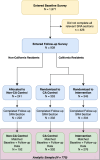Bolstering agreement with scarce resource allocation policy using education: a post hoc analysis of a randomized controlled trial
- PMID: 40229711
- PMCID: PMC11995607
- DOI: 10.1186/s12913-025-12712-x
Bolstering agreement with scarce resource allocation policy using education: a post hoc analysis of a randomized controlled trial
Abstract
Background: The COVID- 19 pandemic prompted rapid development of scarce resource allocation policies (SRAP) in case demand for critical health services eclipsed capacity. We sought to test whether a brief, educational video could improve alignment of participant values and preferences with the tenets of the University of California Health's SRAP in a post hoc analysis of a randomized controlled trial (RCT) conducted during the pandemic.
Methods: An RCT of an educational video intervention embedded in a longitudinal web-based survey conducted from May to December 2020, analyzed in August 2024. The "explainer" video intervention was approximately 6 min long and provided an overview of the mechanics and ethical principles underpinning the UC Health SRAP, subtitled in six languages. California residents were randomized to view the intervention or not, stratified by age, sex, education, racial identity, and self-reported health care worker status. Non-California residents were assigned to the control group. 1,971 adult participants were enrolled at baseline, and 939 completed follow-up. 770 participants with matched baseline and follow-up responses were analyzed. Self-reported survey assessments of values regarding components of SRAP were scored as the percentage of agreement with the UC Health SRAP as written. Participants responded to items at baseline and follow-up (approximately 10 weeks after baseline), with randomization occurring between administrations.
Results: After the intervention, overall agreement improved by a substantial margin of 5.2% (from 3.8% to 6.6%, P <.001) for the intervention group compared to the control group. Significant changes in agreement with SRAP logistics and health factors were also observed in the intervention group relative to the control, while no significant changes were noted for social factors. Differential intervention effects were observed for certain demographic subgroups.
Conclusions: A brief educational video effectively explains the complex ethical principles and mechanisms of the SRAP, as well as how to improve the alignment of participant values with the foundational principles of UC Health SRAP. This directly informs practice by providing a framework for educating individuals about the use of these policies during future situations that require crisis standards of care, which can, in turn, enhance agreement and buy-in from affected parties.
Trial registration: ClinicalTrials.gov registration NCT04373135 (registered 4 May 2020).
Keywords: Crisis standards of care; Critical care; Internet-based survey; Patient education; Scarce resource allocation.
© 2025. This is a U.S. Government work and not under copyright protection in the US; foreign copyright protection may apply.
Conflict of interest statement
Declarations. Ethics approvals and consent to participate: The UCLA Institutional Review Board (20–000683) reviewed and approved this study in accordance with the provisions in the Declaration of Helsinki. All participants provided electronic informed consent. Consent for publication: Not applicable. Competing interests: Dr. Buhr reports personal consulting fees for DynaMed/American College of Physicians and Optum and serving on an advisory board for Chiesi, unrelated to this work and is an employee of the Veterans Health Administration. The views and positions in this manuscript do not necessarily reflect those of the Department of Veterans Affairs. Drs. Huang, Wisk, and Ms. Romero have nothing to report.
Figures


Similar articles
-
Promotion of Knowledge and Trust Surrounding Scarce Resource Allocation Policies: A Randomized Clinical Trial.JAMA Health Forum. 2024 Oct 4;5(10):e243509. doi: 10.1001/jamahealthforum.2024.3509. JAMA Health Forum. 2024. PMID: 39422889 Free PMC article. Clinical Trial.
-
Interventions for preventing and reducing the use of physical restraints for older people in all long-term care settings.Cochrane Database Syst Rev. 2023 Jul 28;7(7):CD007546. doi: 10.1002/14651858.CD007546.pub3. Cochrane Database Syst Rev. 2023. PMID: 37500094 Free PMC article.
-
The effect of sample site and collection procedure on identification of SARS-CoV-2 infection.Cochrane Database Syst Rev. 2024 Dec 16;12(12):CD014780. doi: 10.1002/14651858.CD014780. Cochrane Database Syst Rev. 2024. PMID: 39679851 Free PMC article.
-
Sexual Harassment and Prevention Training.2024 Mar 29. In: StatPearls [Internet]. Treasure Island (FL): StatPearls Publishing; 2025 Jan–. 2024 Mar 29. In: StatPearls [Internet]. Treasure Island (FL): StatPearls Publishing; 2025 Jan–. PMID: 36508513 Free Books & Documents.
-
SARS-CoV-2-neutralising monoclonal antibodies for treatment of COVID-19.Cochrane Database Syst Rev. 2021 Sep 2;9(9):CD013825. doi: 10.1002/14651858.CD013825.pub2. Cochrane Database Syst Rev. 2021. PMID: 34473343 Free PMC article.
References
-
- Daugherty Biddison EL, Faden R, Gwon HS, Mareiniss DP, Regenberg AC, Schoch-Spana M, Schwartz J, Toner ES. Too many patients…a framework to guide statewide allocation of scarce mechanical ventilation during disasters. Chest. 2019;155(4):848–54. - PubMed
-
- Emanuel EJ, Persad G, Upshur R, Thome B, Parker M, Glickman A, Zhang C, Boyle C, Smith M, Phillips JP. Fair allocation of scarce medical resources in the time of Covid-19. N Engl J Med. 2020;382(21):2049–55. - PubMed

